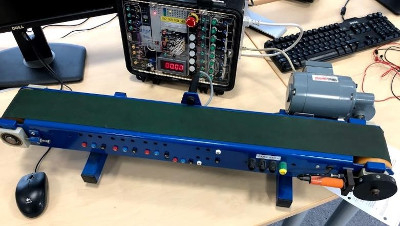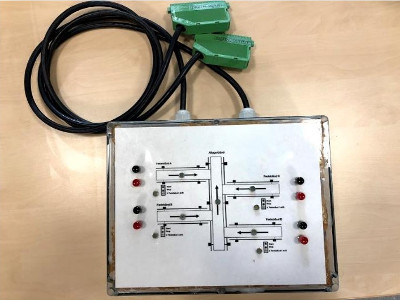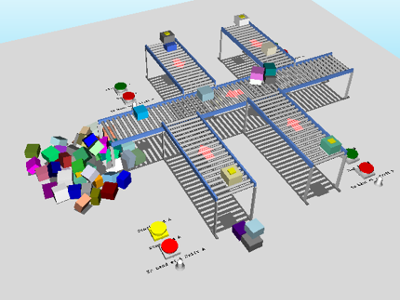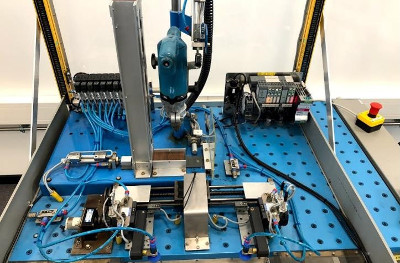More schools use Digital Twins: “Just get started”
More schools use Digital Twins: “Just get started”
At the Copenhagen School of Marine Engineering and Technology Management, they know that Digital Twins are the future in the industry and to keep up with the development, they use Experior in the classroom.
When big companies in the industry such as TGW Logistics Group and BEUMER Group commission their large systems, they first test the control software on a Digital Twin to ensure the quality and minimize the commissioning time. Likewise, when lecturer Søren Hviid Junker’s students in Automation does their exam projects, they need to test their programming on a Digital Twin in Experior first.
“We can see that this is the way they work out there in the real world, and we need to keep up and prepare our students for the reality in the industry,” says Søren Hviid Junker from the Copenhagen School of Marine Engineering and Technology Management. During his 11 years at the school, he has witnessed firsthand how they’ve taken in the concept of Digital Twins.
“Digital Twins are now a known teaching method here, so the students are very open to that way of working,” he says.
From simple models to complex systems
Søren Hviid Junker has used Experior for about 9 years now, but together with Xcelgo he has taken it to another level during the last couple of years. Now, Digital Twins are integrated in almost every step of his Automation classes, where students will start out using simple Digital Twins that will gradually grow more and more complex.
To get to know the concept, new students train simple programming with a simple conveyor and a corresponding Experior model (see Images 1). This gives them a sense of the benefits from working with a digital model that is an accurate representation of the physical system and prepares them to work with more complex models and systems.
Afterwards, the students start working with Experior models that don’t have a physical twin at the school. In the past, students would use boxes like the one pictured on the right (see Images 2) to test their PLC programming, but now they use models in Experior that are much more alive and realistic.
To finish the course, the students have an exam where they program a PLC for a physical drill sequence model or a sorter model at the school. Before they connect their programming to the actual model, they must test the PLC on a Digital Twin developed by Xcelgo (see Images 3).
Better education and happier students
According to Søren Hviid Junker, the benefits from using Experior in the classroom are plenty:


Images 1: Conveyor used for PLC programming for beginners
Hover to see the corresponding Experior model
Hover to see the corresponding Experior model


Images 2: A conveyor system model used for PLC testing
Hover to see the Experior model now used
Hover to see the Experior model now used


Images 3: Drill sequence model used for PLC programming exams
Hover to see its Digital Twin in Experior used for validation
Hover to see its Digital Twin in Experior used for validation
“The flow and concentration level during the sessions is must better, as students each have a model on their computer. That means no waiting time and no rush to get a hold of one of the few physical models that we have,” he says. This is a big benefit for schools running on a tight budget:
“The school can’t afford to buy enough physical systems for all the students, and it is much cheaper for me to use a couple of days to develop a good Experior model, than it is to buy the actual system”, Søren Hvid Junker says.
On top of the benefits for the teachers and the school, students are also very happy with this way of working:
“After our first exams using Experior, the students responded very well and in our evaluations, they often ask for more Digital Twins”, he says.
The companies that Søren Hviid Junker’s students intern at also seem pleased to have interns with this set of skills, as most of his interning students will get a job the same place afterwards.
If you just start out simple and work with what you have, you quickly find out how it works. From there, it is easy to take the next steps
Just get started!
All in all, the benefits of teaching with Digital Twins way outweigh any implementation problems that might arise. Actually, it isn’t even that difficult to get started, if you ask Søren Hviid Junker:
“If you just start out simple and work with what you have, you quickly find out how it works. From there, it is easy to take the next steps,” he says and urges other schools to get on board:
“To put it simply: Just get started! We are happy to help and to share Experior models with other schools. If the schools work together and share models, we will be able to work with a larger range of systems than otherwise possible”, Søren Hviid Junker says.
Already, he has such a collaboration with Aarhus School of Marine and Technical Engineering, where they also use Experior. You can read more about their use of Experior here.
